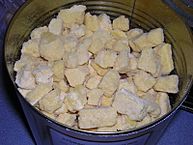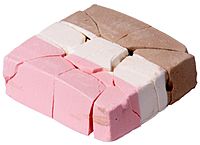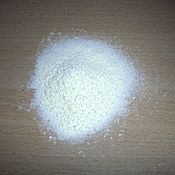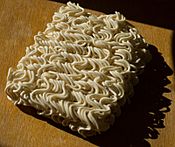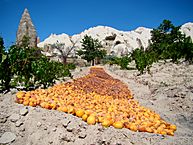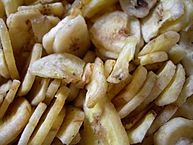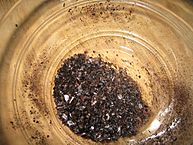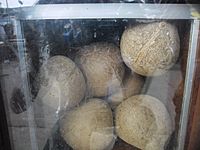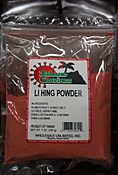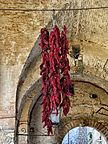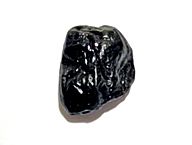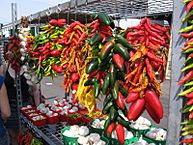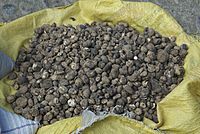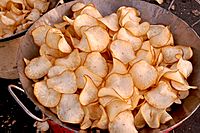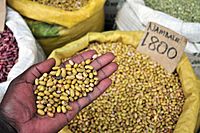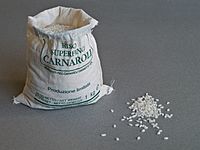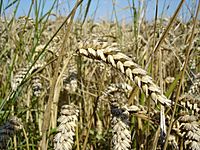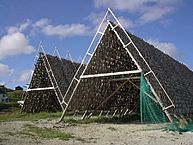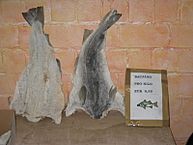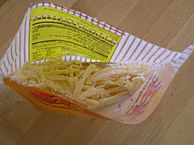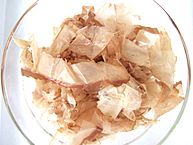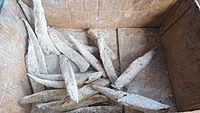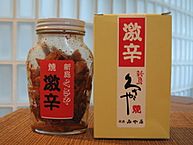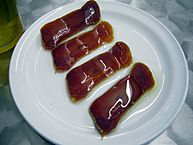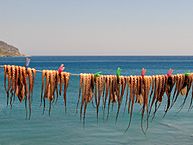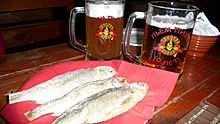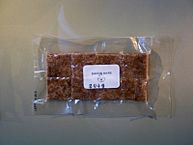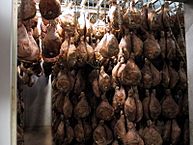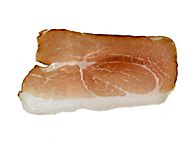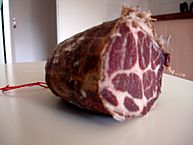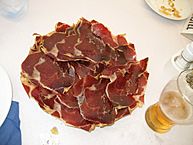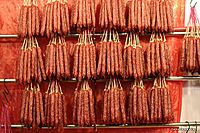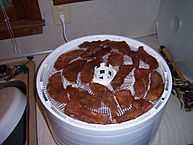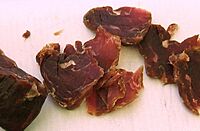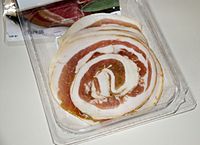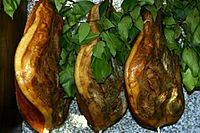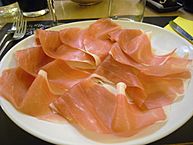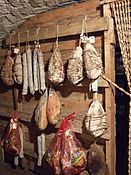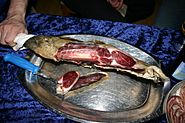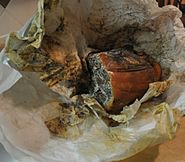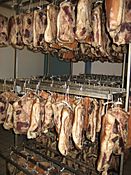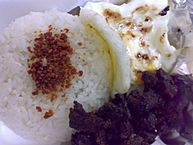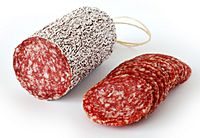List of dried foods facts for kids
This is a list of dried foods. Food drying is a way to keep food fresh by taking out its water. This stops tiny germs like bacteria from growing. People have used this method for a very long time, even since 12,000 BC in the Middle East and Asia!
Contents
What Are Dried Foods?
Dried foods are items that have had most of their water removed. This helps them last a long time without going bad. Drying food is one of the oldest ways humans have preserved what they eat.
Dried Processed Foods
Processed foods are items that have been changed from their original form. Many of these can also be dried to make them last longer or easier to use.
Common Dried Processed Foods
- Baker's yeast is a tiny living thing used to make bread, cakes, and pies rise. It's sold as a dry powder.
- Bouillon cubes are small cubes of dried broth. They are made from dried vegetables, meat stock, salt, and spices. You just add hot water to make a tasty soup or broth!
- Instant breakfast is usually a powder you mix with milk to make a drink. It's a quick way to have breakfast, like Carnation Instant Breakfast, which came out in 1964.
- Instant coffee is made from brewed coffee beans that have been dried, either by freezing or spraying. You just add hot water to make a cup of coffee.
- Powdered eggs are eggs that have been completely dried into a powder. They can last 5 to 10 years if stored well. Freeze-dried eggs can last even longer, up to 25 years!
- Freeze-dried ice cream is ice cream with most of its water removed. It doesn't need to be kept cold and comes in a pouch. It became famous as a food for astronauts, though they didn't love it!
-
Freeze-dried ice cream, Neapolitan flavor
- Edible jellyfish is often dried with salt to preserve it.
- Kashk is a food from sour milk or yogurt, found in many Middle Eastern and Central Asian dishes. It's made by drying the milk or yogurt into balls, strips, or chunks.
- Evaporated milk is canned milk with about 60% of its water removed. It's different from sweetened condensed milk because it doesn't have added sugar.
- Powdered milk is a dairy product made by drying milk. It's usually made by spraying milk into a hot chamber, where the water quickly evaporates, leaving fine powder.
- Non-dairy creamer is a liquid or powder that replaces milk or cream in coffee and other drinks.
- Instant noodles are dried, cooked noodles that usually come with flavor packets. Ramen is a very popular type of instant noodle.
- Nutritional yeast is sold as flakes or a yellow powder. It's used as a food supplement because it's full of good nutrients.
- Instant oatmeal is cooked oatmeal that has been dried. You just add hot water to make it ready to eat.
-
Instant ramen
- Snack bars or food bars are pressed cakes of grains, nuts, and fruits. They are a good source of energy when you can't prepare a full meal.
- Instant soup comes as a dry mix. You just add water and heat it up, or sometimes just add hot water directly.
- Portable soup was a type of dried food used in the 18th and 19th centuries. It was an early version of today's meat extracts and bouillon cubes.
- Tarhana is a dried soup from Central Asia.
- Instant tea is a powdered mix that you add water to, to make a cup of tea.
- Tempeh is soybeans pressed into a cake and fermented. When dried, it can last for several months.
- Terasi (or trassi) is an Indonesian dried shrimp paste, often pressed into dry blocks or sold as a powder.
Dried Plant Foods
Many parts of plants, like fruits, vegetables, and seeds, can be dried to preserve them.
Dried Fruits
Dried fruit is fruit that has had most of its water removed. This can happen naturally by sun-drying or by using special machines called dehydrators. Dried fruit has been used since 4000 BC in Mesopotamia. People love it for its sweet taste, nutrients, and long shelf life.
Popular Dried Fruits
- Ancho chili is the dried form of the poblano chili pepper.
- Apple chips are thin, dried slices of apple.
- Dried apple can be eaten as is or soaked in water to soften it for cooking.
- Dried apricot can be dried whole or in halves, with or without their seeds.
- Banana chips are dried or deep-fried slices of bananas, popular in Brazil, Indonesia, and India.
- Black lime is a spice from the Middle East. It's made by boiling fresh limes in salt water and then sun-drying them until they turn black inside.
-
Apricots drying on the ground in Turkey
-
Dried banana chips
-
Dried, ground Persian black lime
- Chenpi is sun-dried tangerine peel. It's used as a seasoning in Chinese cooking and traditional medicine.
- Dried cherries are sweet and chewy.
- Chipotle is a smoked, dried jalapeño pepper.
- Coconut can be dried whole or shredded. Shredded dried coconut is a common product.
- Dried cranberry is made by partly drying fresh cranberries, similar to how grapes become raisins.
- Dates are the fruit of the date palm tree and are often sun-dried.
- Dried figs are used in many foods, like fig rolls.
- Traditional dried fruits include sun-dried fruits like raisins and figs, or those dried in special tunnels, like prunes, apricots, and peaches.
- Goji berries are usually sold dried. They are traditionally cooked before eating. They are dried in the sun or by machines.
- Gotgam is the Korean name for dried persimmon.
- Guajillo chili is a dried type of mirasol chili pepper.
- Lavashak is a Persian fruit leather made from plums, apricots, or pomegranates.
- Li hing mui is a salty dried plum, also called huamei in China. It became popular in Hawaii. The red li hing powder is made from ground plum skin, licorice, and other flavors.
-
Red li hing mui sold in Maui, Hawaii
-
Packaged li hing powder found in Hawaii
- Dried mangoes are dried slices of mango fruit. The Philippines and India are known for producing them. In India, 'amchur' is a popular dried mango powder used in cooking.
- Nuts are botanically fruits, but in cooking, many dried seeds are also called nuts.
- Papaya can be dried.
- Pasilla is the dried form of the chilaca chili pepper.
- Peperone crusco (or "Crusco pepper") is a dried, sweet pepper from Basilicata, Italy.
- Pink peppercorn is a dried berry from the Peruvian peppertree.
- Prunes are dried plums. Over 1,000 types of plums are grown just for drying!
-
Chains of peperoni cruschi in Rotondella, Basilicata
-
A prune
-
Ristras of jalapeños, other chili peppers, and garlic at a market in Montreal
- Raisins are dried grapes. They are made in many parts of the world and can be eaten raw or used in cooking and baking.
- A ristra is a string of drying chili pepper pods, used for both drying and decoration.
- Saladitos are dried, salted plums. They can also be sweetened or coated in chili and lime.
- Tklapi is a puréed fruit leather.
- Sun-dried tomatoes are ripe tomatoes that have lost most of their water by drying in the sun. They are often treated with sulfur dioxide or salt to improve their quality.
- Watermelon can be freeze-dried or rack-dried like other fruits and vegetables, keeping its nutrients.
- Wolfberry or "goji berry" is a fruit that is often dried.
Dried Vegetables
Many vegetables can be dried, such as potatoes, beans, carrots, corn, and onions.
Examples of Dried Vegetables
- Chuño is a freeze-dried potato product traditionally made by the Quechua and Aymara people in Bolivia and Peru.
- Daikon cut and dried is called kiriboshi daikon in Japan. It needs to be soaked in water before cooking.
- Hoshi-imo is a Japanese snack made from dried sweet potatoes.
- Lefse is a Norwegian flatbread made with potatoes. When dried, it can last up to 6 months.
- Nori is the Japanese name for edible dried seaweed sheets. It's used to wrap sushi rolls and as a garnish in soups.
- Instant mashed potatoes are potatoes that have been cooked, mashed, and then dried. You can quickly make mashed potatoes at home by adding hot water or milk.
- Vegetable chips can be made by simply drying or by frying sliced vegetables.
Dried Seeds
Seeds are also commonly dried for food.
Common Dried Seeds
- Beans are large plant seeds used for food. Dried beans include kidney beans, black beans, and pinto beans.
- Grains like wheat, corn, soybeans, and rice are dried in special grain dryers. Drying reduces their moisture so they can be stored for a long time. Other grains include lentils, wild rice, chickpeas, and millet.
- Some types of maize (corn) are dried to make popcorn. The kernels are dried to the perfect moisture level so they pop well when cooked.
-
Grains at a market
Dried Fungi
- Dried mushrooms are prepared by sun-drying, hot-air drying, or freeze-drying. Popular dried mushrooms include shiitake and morel mushrooms.
- Mushroom extract is a thick, concentrated paste made from dried edible mushrooms. It's used to add mushroom flavor to soups and sauces.
Dried Animal Foods
Meat has been preserved by drying and smoking since ancient times.
Dried Fish and Seafood
Drying fish is a way to preserve fish by removing its water, which stops tiny germs from growing. People have dried fish in the open air using sun and wind since ancient times. Fish are also preserved by smoking and salting.
Types of Dried Fish and Seafood
- Bacalhau is the Portuguese word for cod, and in cooking, it means dried and salted cod. It's a popular dish in Portugal, Brazil, and parts of Spain.
- Balyk is salted and dried soft parts of large fish, like sturgeon or salmon.
- Bokkoms are whole, salted, and dried mullet fish from South Africa.
- Boknafisk is a type of stockfish that is partially dried by sun and wind. It's mostly eaten in North Norway.
- Budu is a sauce made by fermenting anchovies and salt for several months.
- Dried clams are a seafood product.
- Dried Cod skin is popular as a dog treat.
- Dried and salted cod (or "salt cod") is cod preserved by drying after salting. If it's dried without salt, it's called stockfish.
- Conpoy is a dried seafood product made from the muscle of scallops.
- Craster kippers are kippers (smoked herring) from the village of Craster in England.
- Daing (also known as Tuyô or Bilad) refers to dried fish from the Philippines. A type called labtingaw is dried for a shorter time and is still slightly moist.
-
Boknafisk drying on hjells in Norway
-
Salted and dried cod, produced in Norway
-
Commercially prepared dried shredded squid
- Fesikh is a traditional Egyptian fish dish made from fermented, salted, and dried gray mullet.
- Gwamegi is a Korean half-dried Pacific herring or saury, made in winter. It's popular in certain regions of Korea.
- Juipo is a traditional Korean pressed fish jerky, made from filefish. It's dried, flattened, and seasoned, and sold as a street snack.
- Katsuobushi is the Japanese name for dried, fermented, and smoked skipjack tuna. It's often shaved into flakes for cooking.
- Keumamah is a traditional Acehnese dried fish.
- Kipper is a whole herring that has been split, gutted, salted, and cold-smoked.
- Kusaya is a salted-dried and fermented fish from Japan. It has a strong smell but a mild taste.
-
Katsuobushi shavings from a package
-
Kippered "split" herring
-
Bottled kusaya from Niijima
- Lutefisk is a Norwegian preserved food made from whitefish soaked in lye and then salted and air-dried.
- Mackerel is dried in Greece, Turkey, and Cyprus.
- Maldives fish is cured tuna fish traditionally made in the Maldives. It's a key part of Maldivian and Sri Lankan cooking.
- Mojama is a Spanish delicacy of salt-cured tuna loins.
- Meat Floss is a Chinese dried and powdered meat product.
- Octopus can be dried to preserve it.
-
Octopus being sun-dried in Greece
- Piracuí is known as "farinha de peixe" (fish meal) in the Brazilian Amazon. It's made from dried, salted fish that is crushed.
- Prawn cracker is a deep-fried snack made from tapioca flour and prawn.
- Sanyaa is a type of dried fish prepared by the Newar people.
- Dried shrimp are sun-dried and shrunken shrimp. They are used in many Asian dishes for a unique savory taste.
- Shũṭki or Shũṭki machh is sun-dried fish or shrimp prepared in Bengali and Assamese cuisine.
- Dried shredded squid is a dried, seasoned seafood product from squid or cuttlefish, found in coastal Asian countries and Hawaii.
- Stockfish is unsalted fish, usually cod, dried by cold air and wind on wooden racks.
- Tatami iwashi is a Japanese food made from baby sardines laid out and dried to form a mat-like sheet.
- Vobla is salt-dried vobla, a common Russian snack that goes well with beer.
Dried Meats
Dried meat is a popular food in many cultures around the world.
Types of Dried Meats
- Apohtin is a traditional Cypriot dried food made from salted goat meat.
- Bacon can be freeze-dried.
- Bakkwa is a Chinese salty-sweet dried meat product, similar to jerky, made using a traditional preservation method.
- Bayonne ham is an air-dried salted ham from France. It has a slightly sweet, delicate flavor.
- Biltong is a cured meat from Southern Africa, made from beef, game, or ostrich. It's typically made from raw meat fillets.
- Black Forest ham is a dry-cured smoked ham from Germany. It's the best-selling smoked ham in Europe.
- Borts is Mongolian air-dried meat, prepared by cutting meat into long strips and hanging them in the shade.
- Bresaola is air-dried, salted beef that has been aged until it becomes hard and dark red. It's lean and tender, with a sweet smell.
- Brési is beef that has been salted, dried, and smoked for about three months in France.
- Bündnerfleisch is air-dried beef from Switzerland. The meat is treated with white wine and seasonings before drying.
-
freeze-dried bacon bars
-
Bayonne hams aging in an atmospherically-controlled storage room in Mazerolles, Béarn
-
Sliced Black Forest ham
- Kabanos is a type of dry sausage, like a mild salami, made from pork and beef, lightly seasoned and smoked.
- Capicola is a traditional Italian dry-cured pork shoulder or neck.
- Carne-de-sol is a dish from Northeastern Brazil, made from heavily salted beef exposed to the sun for a day or two to cure.
- Carne seca is a type of dried beef in Mexican cuisine. In northern Mexico, it's used in a dish called machaca.
- Carne-seca is a type of dried, salted meat, usually beef, in Brazilian cuisine, often eaten with black beans.
- Cecina in Spanish means "meat that has been salted and dried by air, sun, or smoke." It's similar to ham but made from beef, horse, or other meats.
- Charcuterie is the art of preparing meat products like bacon, ham, and sausages. It was originally a way to preserve meat before refrigeration.
- Charque is a type of jerky common in South America, made from dried and salted meat, usually beef.
- Chinese sausage is a general term for many different types of sausages from China.
- Chipped beef is thinly sliced or pressed salted and dried beef. Some types are smoked for extra flavor.
- Chorizo can be a fresh sausage that needs cooking, or a fermented, salt-cured, smoked sausage.
- Cold cuts are precooked or cured meats, including dried sausages.
- Country ham is a very salty cured ham, salt-cured for one to three months.
- Culatello is a refined type of prosciutto, made from heavier pigs and aged, sometimes cured with wine.
-
Coppa Spécialité Corse, a variety of capicola
-
Dried Chinese sausages
- Droëwors is a Southern African snack food based on a traditional sausage, dried.
- Droge worst is a Dutch dried sausage snack.
- Elenski but is a dry-cured ham from Bulgaria, known for its special taste and long preservation due to its unique making process and climate.
- Fenalår is salted, dried, and cured leg of lamb from Norway. It's a very popular dish, often served in thin slices.
- Genoa salami is an American type of salami, usually made from pork, seasoned with garlic, salt, peppers, fennel seeds, and wine.
- Hungarian sausages come in many types, boiled, fresh, or dried and smoked, with different spices.
- Jamón ibérico ("Iberian ham") is an expensive ham made from black Iberian pigs, produced in Spain and Portugal.
- Jamón serrano or simply Jamón is a type of dry-cured ham from Spain, often served in thin slices. It's one of the most famous Spanish foods.
- Jerky is lean meat that has been trimmed of fat, cut into strips, and dried to prevent spoilage. Salt is usually added to help preserve it.
- Jinhua ham is a dry-cured ham from China, used to flavor stews, braised foods, and Chinese soups.
-
Raw meat before dehydration into jerky
- Kilishi is a version of biltong or jerky from Hausaland, made from cow, sheep, or goat meat.
- Kuivaliha is salted and dried meat, often reindeer, a traditional food from northern Finland.
- Kulen is a highly spiced, semi-dried, smoked, cured sausage from Croatia and Serbia.
- Lacón Gallego is a dried ham product from Galicia, Spain, made from specific pig breeds and only using the pork shoulder.
- Lahndi is a winter food popular in Northern Afghanistan, usually made from lamb and sheep.
- Lomo embuchado is a dry-cured meat made from pork tenderloin, similar to cecina but with pork.
- Lountza is a Cypriot delicacy of dried, smoked pork tenderloin.
-
Kuivaliha, in the form of dried reindeer meat
- Machaca is a dish prepared from dried, spiced beef or pork, which is then rehydrated and pounded.
- Meat extract is a highly concentrated meat stock, usually from beef. It's used to add meat flavor to cooking.
- Njeguška pršuta is a dry-cured ham from Montenegro, similar to Italian prosciutto. Its unique flavor comes from the mix of sea and mountain air during drying.
- Pancetta is Italian bacon, which is salt-cured pork belly meat. It's often cubed or sliced.
- Pastirma is a highly seasoned, air-dried cured beef from Anatolia, now part of many former Ottoman cuisines.
- Pastrami is a popular deli meat, usually made from beef. Like corned beef, pastrami was created to preserve meat before refrigeration.
- Pemmican is a historic food, a concentrated mix of fat and protein used as a nutritious food.
- Pepperoni is an American type of salami, usually made from cured pork and beef. It's soft, slightly smoky, and bright red.
- Pinnekjøtt is a Norwegian main course dish of lamb or mutton, prepared using traditional curing, drying, and sometimes smoking methods.
- Pitina is an Italian cold cut from the mountain valleys of northeastern Italy.
- Presunto is the name for dry-cured ham from Portugal.
- Prosciutto is a dry-cured ham that is usually thinly sliced and served uncooked.
-
Packaged pancetta
-
Presunto of Chaves
-
Prosciutto di Parma
- Rousong is a dried meat product with a light, fluffy texture, like coarse cotton. It's from China and used as a topping for many foods.
- Salami is a cured, fermented, and air-dried meat sausage. Historically, it was popular because it could be stored at room temperature for a long time.
- Salumi are Italian cured meat products, mostly from pork. The term comes from the Italian word for "salted meat."
- Secca de bœuf is a type of dried salted beef made in France, similar to Swiss Bindenfleisch.
- Skerpikjøt is a type of wind-dried mutton, a delicacy of the Faroe Islands.
- Slinzega is a type of air-dried meat from the Italian Alps, similar to Bresaola but with smaller pieces of meat and a stronger taste.
- Smithfield ham is a specific type of country ham from Smithfield, Virginia, cured by a long dry salt method and aged for at least six months.
- Soppressata is an Italian dry salami.
- Speck often refers to Italian Speck, a type of prosciutto.
- Suho meso is a smoked beef food eaten in Bosnian and Serbian cuisine.
- Sukuti is the Nepali word for dry meat (jerky). It can be eaten directly, spiced as a snack, or mixed with other ingredients as a side dish.
-
Aging salumi
-
Skerpikjøt is dried mutton, and is a typical food in the Faroe Islands.
-
Smoked speck
- Tapa is a Filipino food made from dried or cured beef, mutton, or venison. Thin slices of meat are cured with salt and spices.
- Tolkusha is a type of dried meat.
- Tsamarella is a Cypriot traditional food made from salted and cured goat meat, traditionally dried in the sun.
- Tyrolean Speck is a juniper-flavored ham from Tyrol, an historical region now partly in Italy. It's made from pig hind leg, deboned, cured, and then cold-smoked slowly.
- Winter salami is a type of Hungarian salami based on old traditions. It's made from mangalitsa pork and spices, cured in cold air, and smoked slowly.
-
Tapa (at bottom)
-
Téliszalámi (winter salami)
Images for kids
-
Dry common beans
-
Flattened fish drying in the sun in Madagascar
-
Dried shrimp for sale near Bến Thành Market, Saigon
-
Country ham aging on racks
-
Charcuterie in Jura, France
-
Droëwors pieces
-
Csabai kolbász, a type of Hungarian sausage
-
Pork machaca; eggs and potatoes wrapped in a tortilla, served with salsa
See also
- Cuisine
- Cured fish
- Curing
- Food dehydrator
- Food processing
- Freeze-drying
- List of instant foods
- List of sausages
- List of smoked foods
- Salting
- Smoking



